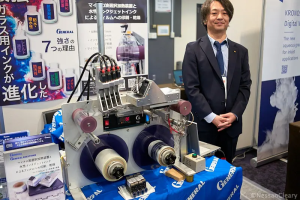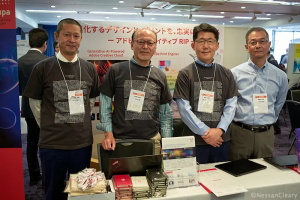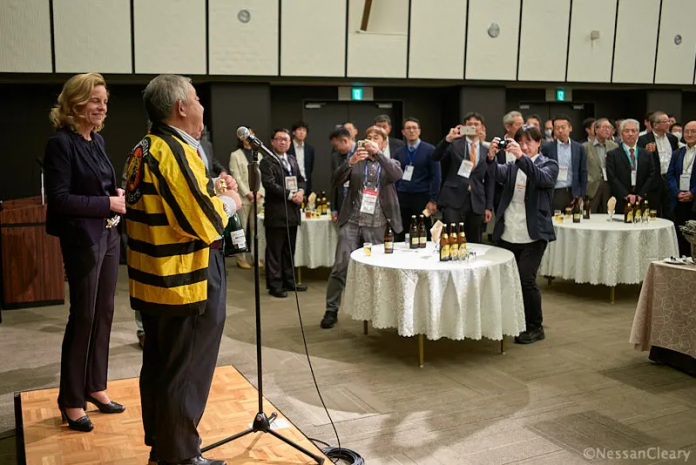This is the third and final part of my report from the Japan Inkjet Technology Fair (JITF) that was held in Tokyo at the end of October, 2023. The event brought together a cross section of suppliers from software and component developers through to press manufacturers in an attempt to build a community spirit, with a mix of conference presentations and table top technology demonstrations.
So far I’ve covered some of the printhead and ink suppliers. For this story I’m going to write more about integrators and machine builders, starting where I left off the last story, with electron beam curing.
Masei Kamei, director of Miyakoshi, says that the advantage of EB curing is that it is very power efficient as there’s no need for the large drying system that water-based inks require. Such drying systems add to the footprint, the complexity and, therefore, the cost of presses with water-based ink. He adds, “EB has very little power supply so I think this is a good technology for the future.”
Tets Uchida, Miyakoshi’s marketing director, says that Miyakoshi is looking into developing an offset press with electron beam curing for the food packaging market. He says that offset is more attractive than flexo for customers transitioning from gravure because it’s easier to make plates for offset use, particularly with the widespread acceptance of processless plates. He adds: “The ink is easier and the density is more consistent than with flexo.”
Uchida explains, “We are looking for flexible packaging more and more so we are targeting gravure printing companies shifting to offset for shorter run flexible packaging.” He adds: “Customers are looking for inkjet and other technologies because the run lengths are getting shorter. We are pushing offset because it will be easier for gravure customers to shift the plate making. But also we are developing flexo so we are looking for the right balance for customers. For larger volumes, water-based inks with flexo but for mid-volumes will be EB offset.”
Iwasaki mainly makes lighting and optical systems, including UV and EB curing. It has developed a system that combines EB with UV curing. The idea is to use the UV curing between the colors followed by an EB lamp for a final cure. The UV curing uses very short wave lengths so that there’s no need for a photo-initiator in the ink. Takayuki Sakayori, assistant manager for sales and marketing for Iwasaki, says, “We are working with several ink companies.”
Kamei says that the main disadvantages of EB curing are the very high cost of the lamps plus a tendency for the ink droplets to flow slightly, affecting edge definition and color mixing. So the Iwasaki approach of using UV for inter-color curing is a good way of solving both of these issues.
Tritek is one of the oldest integrators in Japan, dating to 1994. The company was set up by its president, Kazuyoshi Takahashi, who previously worked for Canon. He showed a number of interesting samples, including very highly decorated clear plastic and metal water bottles that had a very textured surface. This, in turn, increases the value of those products, so that his customers can charge more for them. The degree of texture and decoration does not significantly affect the cost of the printing but does have a direct influence on the final value of those items.

Tritek works with a number of different head suppliers, including Konica Minolta, Kyocera, Seiko Epson, Ricoh, Fujifilm Dimatix and Toshiba Tec, most of whom were also present at this event. He says: “We also developed our own controller board and software, with different boards for each type of printhead.” He adds that more recently Tritek has started buying in components from GIS “because we must customize the semiconductor for some special function to answer the customer requirements.”
Tritek has also developed a number of printers that can be integrated into a production line for various industries, including building materials. There’s also an inkjet press for flexible films called the RollJet FP. This takes OPP, PET and nylon films up to 540mm wide and prints with water-based inks using CMYK plus white. It can run at 80 mpm. Tritek has also developed an EB curing system, with the lamps coming from another Japanese supplier, Hamamatsu, which also exhibited at the same event.
Mastermind brought along its MMP X210 printer, which uses an Epson piezo printhead. The company is well-known in Japan for producing food printers so it was shown with printed cookies! Keisuke Ozawa, president of Mastermind, explained: “Most of the components come from Epson but we create our own main board so that we can give it our own controller.”
He says that the cost of inkjet often puts off industrial customers, explaining: “In Japan you have to find the right head and boards and have to hire expensive engineers. But our company is small and our customers are small businesses so they find inkjet technology too expensive. I wanted to make it a bit easier and cheaper for them and we came up with this idea. We have a controller board that’s good enough to control A4 and A3+ size and give a lot of freedom such as accepting a connection from outside so that they can integrate the printer unit to another machine such as a vending machine or a conveyor belt.”
It costs around $16,000. Ozawa notes: “We try to make it affordable so it’s easy to buy them without any risk. And companies can buy several if they need. Lots of companies provide robot arms so it can be integrated with these.” There’s a choice of different inks depending on the application.

General Solutions, which I covered at last year’s event, returned with an updated version of the film printer it showed previously. This prints to PET films with a water-based ink and uses a microwave system to cure the ink instantly. This year’s model is wider, up to 80cm. Hideyuki Uemura, sales and engineering with General Solutions Ltd, says: “Our customers want to use it for barcodes.” The ink contains an adhesive to help it stick to the film. It runs at 16 mpm with 300 x 600 dpi resolution. Uemura says that it’s still in development.
I also had a very interesting conversation with Makoto Aruga, managing director of the Digital Imaging Group. DIG distributes a number of brands in Japan , including EFI, Landa and Memjet, so that Aruga is very well-positioned to understand the Japanese digital print market. He showed a number of very good print samples produced on the EFI Nozomi that highlighted its ability to print with white ink. Most press manufacturers believe that the market is shifting to water-based inks because it is more sustainable and better-suited to food packaging. But EFI continues to use UV-curable inks with the Nozomi, and as Aruga points out, the ability to print with white ink is a major advantage over water-based inks, where white is still fairly rare.

He told me, “The white ink has shortened the process for direct printing to brown boards,” adding “Water-based inkjet is very difficult for digital white and this is the strongest selling point for EFI.” He explains: “The Japanese market is very conservative. The corrugated board printers have presses with less than three colors so they don’t need to replace these with color machines.”
He says that EFI is also developing a version of the Nozomi that will run aqueous inks but believes that EFI will offer customers a choice of both aqueous and UV ink machines in the future.
Aruga is also pushing an inkjet label press from the Indian manufacturer, Monotech, which uses Memjet printheads. This makes for a relatively cost-effective press that’s able to produce reasonable quality results. However, as Aruga points out, Memjet itself is shifting its business away from the smaller manufacturers in order to concentrate on OEMs that produce higher volume machines, partly to better exploit the features of its more recent printheads, but also because that leads to higher volume ink sales.
He says that the Monotech label press should be a good fit for the Japanese market, noting, “In Japan, the label printers are quite small companies so they can only invest small amounts.” He says that consequently cheaper presses such as the Konica Minolta dry toner AL230 and Epson aqueous Surepress L4000 sell quite well, adding: “But the UV inkjet in the label is very rare.”
Adobe also attended the event. Nobuhisa Kato, Adobe engineering program manager, explained, “We aim for new segments like textile and packaging. So we are learning from customers. And it’s clear that inkjet is a major technology after xerography so this event is very useful for us.”

He says there are particular challenges in areas like textiles, where there are a lot of spot colors to manage. He points out that the Adobe design software is able to read spectral data directly from spectrophotometers, adding: “Then if the viewing conditions change you can recreate the data to match the color for the different applications. So the customers can print more accurate colors.”
He says that another challenge is that the design work is often carried out in countries such as Japan or Europe but that the printing is outsourced to other places like China or Pakistan, adding that Adobe can help with this with better communication between intent and output. He says that Adobe is looking at ways to make color management more intuitive for designers as well as making it easier for printers to create extra channels for effects such as white and varnish, and to carry data through to post-press such as for creating cut lines.
Final thoughts
From a Western perspective, it might not be immediately obvious that there is a need for an event like the JITF, given the large number of Japanese manufacturers that are already involved in inkjet. As the Drupa director Sabine Geldermann noted: “They are sitting in the driving seat when it comes to inkjet technology and solutions.”
Aki Ohno, who founded the event, argues that this is only partly true: “In certain aspects the Japanese industry is quite advanced. There are a lot of head manufacturers and also ink manufacturers with quite good technology. So individual parts they are quite good at.” But he says that often Japanese companies are too cautious to take bold decisions on new projects, adding: “They don’t want to be the first. They like to learn from others.”
Ohno points out that inkjet technology is already going beyond print on paper and that there are a lot of integrators in Europe and China that are taking inkjet to other industries but that this is not happening to the same degree in Japan. He continues: “Maybe this is just because there is a lack of information or community exchange to help each other but Japan is far behind. I want to stimulate Japanese people to wake up, meet people and talk. I want to motivate people to do this.”
And this does seem to be working, judging from the feedback that I picked up at the show. Shigeru Masuda, Adobe’s senior OEM product manager, summed up the feelings of many of the exhibitors that I spoke with: “It’s a good opportunity for us to meet our customers and partners and to hear what they want. Last year we met many partners in this event and they all have a very different approach to their printers so this event is very good for us to study and learn about our partners and their needs.”
Masuda makes a very good point because even though the printing industry is defined by the technology, it’s the people that work in this area that are driving it forward. But that depends on those people meeting with both customers and competitors alike and comparing notes. And this is the real value of the JITF, which allows individuals and companies to see themselves as part of a wider professional community.
Even for me, as a foreigner and out of sync with the culture and the language, it’s been fascinating to see the extent to which everyone has embraced this concept. More to the point, it’s been a chance to see some of the innovation that is bubbling away beneath the surface, much of which will eventually make its way beyond Japan to other markets. Besides this it gave me a good opportunity to pick up some useful insights into various aspects around inkjet printing, which I hope that I’ve managed to pass on in these three stories.
Ohno is already planning for another JITF outing for 2024. The feedback from the event has been extremely positive with 80% of the exhibitors confirming immediately that they intended to return for the next edition. Judging from everything that the vendors and visitors told me, he has successfully established the JITF as an annual event on the calendar for those in the Japanese inkjet industry, which is no mean feat.
You can find further information on the event itself from ohno-inkjet.com.
First published on nessancleary.co.uk on 1 December 2023. Part 1 is here and part 2 here.

















